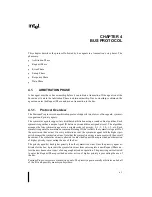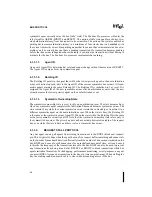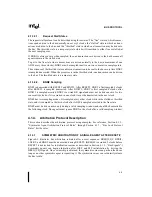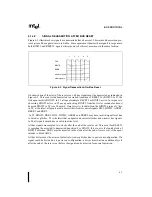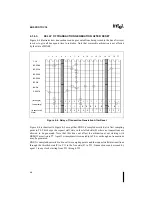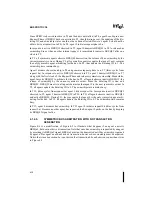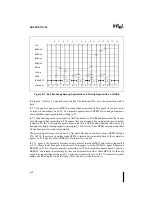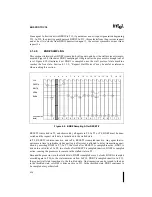
4-13
BUS PROTOCOL
4.1.4.7.
SYMMETRIC AND PRIORITY BUS EXCHANGE DURING LOCK#
Figure 4-8 illustrates an ownership request made by both a symmetric and a priority agent during
an ongoing indivisible sequence by a symmetric owner. When this is the case, LOCK# takes pri-
ority over BPRI#. That is, the symmetric bus owner does not give up the bus to the priority agent
while it is driving an indivisible locked operation. Note that bus agent 1 can hold bus ownership
even though BPRI# is asserted. Like the BREQ[3:0]# signals, if the priority agent is going to
issue a transaction, BPRI# must not be driven inactive until the clock in which ADS# is driven
asserted.
Before T1, agent 0 owns the bus. In T1, agent 0 initiates the first transaction in a bus locked op-
eration by asserting LOCK# along with request 0a. Also in T1, the priority agent and agent 1
assert BPRI# and BREQ1# respectively to arbitrate for the bus. Agent 0 does not deassert
BREQ0# or LOCK# since it is in the middle of a bus locked operation.
In T7, agent 0 initiates the last transaction in the bus locked operation. At the request’s success-
ful completion the indivisible sequence is complete and agent 0 deasserts LOCK# in T11. Since
BREQ1# is observed active in T10, agent 0 also deasserts BREQ0# in T11 to release symmetric
ownership.
The deassertion of LOCK# is observed by the priority agent in T12 and it begins new-request
generation from T13. The deassertion of BREQ0# is observed by all symmetric agents and they
assign the symmetric ownership to agent 1, the agent with active bus request. In T13, all sym-
metric agents update the Rotating ID to one, the Agent ID of the new symmetric owner.
Figure 4-8. Symmetric and Priority Bus Exchange During LOCK#
CLK
BREQ0#
BREQ1#
BPRI#
LOCK#
ADS#
BREQ2#
BREQ3#
{REQUEST}
A
AA
AAAAAA
AA
AA
AAAAAA
AA
A
AAAA
A
A
AAA
AA
A
AAAA
A
A
AAA
AA
A
AAAA
A
AA
AAAAAA
0a
0b
1
2
3
4
5
6
7
8
9
10
11
12
13
14
15
16
A
A
AAAAAA
A
A
AAAAAA
A
AA
AAAAAA
AAAA
AAAA
AAAA
AAAA
AAAA
AAAA
AAAA
AAAA
AAAA
AAAA
AAAA
AAAA
AAAA
AAAA
AAAA
AAAA
AAAA
AAAA
AAAA
AAAA
AAAA
AAAA
AAAA
AAAA
AAAA
AAAA
AAAA
AAAA
AAAA
AAAA
AAAA
AAAA
AAAA
AAAA
AAAA
AAAA
AAAA
AAAA
AAAA
AAAA
AAAA
AAAA
AAAA
AAAA
AAAA
AAAA
AAAA
AAAA
AAAA
AAAA
AAAA
AAAA
AAAA
AAAA
AAAA
AAAA
AAAA
AAAA
AAAA
AAAA
AAAA
AAAA
AAAA
AAAA
AAAA
AAAA
AAAA
AAAA
AAAA
AAAA
AAAA
AAAA
AAAA
AAAA
AAAA
AAAA
AAAA
AAAA
AAAA
AAAA
AAAA
AAAA
AAAA
AAAA
AAAA
AAAA
AAAA
AAAA
AAAA
AAAA
AAAA
AAAA
AAAA
AAAA
AAAA
AAAA
1a
0
0
0
0
0
0
0
0
0
0
0
0
1
1
1
1
{rotating id}
I/Oa
AA
A
AAAA
A
A
AAA
Summary of Contents for Pentium Pro Family
Page 17: ...1 Component Introduction ...
Page 26: ...2 Pentium Pro Processor Architecture Overview ...
Page 27: ......
Page 36: ...3 Bus Overview ...
Page 62: ...4 Bus Protocol ...
Page 105: ...5 Bus Transactions and Operations ...
Page 126: ...6 Range Registers ...
Page 131: ...7 Cache Protocol ...
Page 135: ...8 Data Integrity ...
Page 148: ...9 Configuration ...
Page 161: ...10 Pentium Pro Processor Test Access Port TAP ...
Page 172: ...11 Electrical Specifications ...
Page 201: ...12 GTL Interface Specification ...
Page 229: ...13 3 3V Tolerant Signal Quality Specifications ...
Page 233: ...14 Thermal Specifications ...
Page 239: ...15 Mechanical Specifications ...
Page 241: ...15 2 MECHANICAL SPECIFICATIONS s Figure 15 1 Package Dimensions Bottom View ...
Page 252: ...16 Tools ...
Page 260: ...16 8 TOOLS Figure 16 4 Generic MP System Layout for Debug Port Connection ...
Page 264: ...17 OverDrive Processor Socket Specification ...
Page 290: ...A Signals Reference ...
Page 320: ...Index ...
Page 328: ......



